I have referenced on site on several occasions that I am a watch quite a bit anime. As we approach the end of a decade (see my thoughts on 1-to-0 decades), I decided that it would be a good time to share some of the best and most notable anime series from the last ten years.
Anime Recommendations from the Past Decade (2011-2020)
To start, I will articulate the criteria for the forthcoming list and what you can expect to find.
- This is not an anime ranking, although each of the 10 series I chose are among my favorite series from 2011-2020. While many of the shows would be in any “top 10” that I made, some, like Golden Kamuy, would fall a touch outside of that.
- I chose ten shows based based primarily on two criteria. First, I only chose from shows that were among my favorites from 2011-2020. Second, I chose shows that may be of interest to audiences that do not generally watch anime. Under the second criteria, I omitted many shows that I may have otherwise listed.
- I tried to choose from a variety of genres for the main 10 shows.
- This list is composed of anime series, not movies.
- I restricted the list to anime series that began airing after January 1, 2011. I did not include series that began before that date, even if some entire seasons aired within the 2011-2020 time frame. I am only including shows that are officially licensed in the United States and currently available to stream legally.
- Most of the ten shows will come with additional related show recommendations. The additional recommendations tend to be similar in some respect to the principal recommendation. I personally like some of the additional recommendation shows more than some of my principal recommendations, so being in the “additional” category is not necessarily a reflection of quality – although some of the additional recommendations are not good enough to be principal recommendations.
What is Included with the Show Recommendations?
I will include basic information for each of the 10 featured shows: Number of episodes and air dates, studio, director(s), source material, and where the show is available to stream in the United States. Each of the 10 shows will also include a screenshot, my commentary, and one-to-three additional show recommendations based on the featured series. As I noted above, my criteria for choosing additional recommendations is similar to my criteria for choosing the 10 featured shows.
A Note on How You Can Watch the Shows
All of the shows on my list are available on one of, or some combination of, Crunchyroll, Funimation, and HiDive – all anime streaming platforms. For each show, I will list where it is currently streaming, as of December 28, 2020. (October 2, 2024 Update: Funimation was subsequently absorbed by Crunchyroll. Most of the shows listed as being on Funimation are likely available on Crunchyroll.) I will not provide individual links due to the fact that licenses sometimes expire and shows are pulled, and I would not be on top of things to such an extent that I could fix broken or pointless links expeditiously. Below, you will find the links to the three streaming services I mentioned, and you may use them to look up any shows you are interested in. Some of these shows may also be available on other general-purpose streaming platforms such as Amazon Video, Netflix, and Hulu (one show has an entire season that is exclusive to Netflix).
A Note on My Tastes and Background
I have been watching anime since the latter half of the 2000s. The vast majority of shows that I have watched aired after 2005, but I have seen a decent number of shows from the early 2000s and a few from the 1980s and 1990s. I tend to prefer down-to-earth dramas to action shows (that will be reflected in my choices), but I have no hard-fast rule and watch a variety of genres.
Anime seasons are broken into quarters. Because I generally watch a couple of shows each season, I have seen most of the shows that I would be inclined to watch over the last 10 years. There are shows that I am interested in that I have not seen, however, so it is possible that there are shows out there that I would have included on this list had I seen them.
Finally, I watched every show on my list with Japanese audio and English subtitles. While some of the shows listed below do have English dubbed versions available, I have not seen them. All of my recommendations are based solely on the subtitled versions of the listed shows.
March Comes in like a Lion
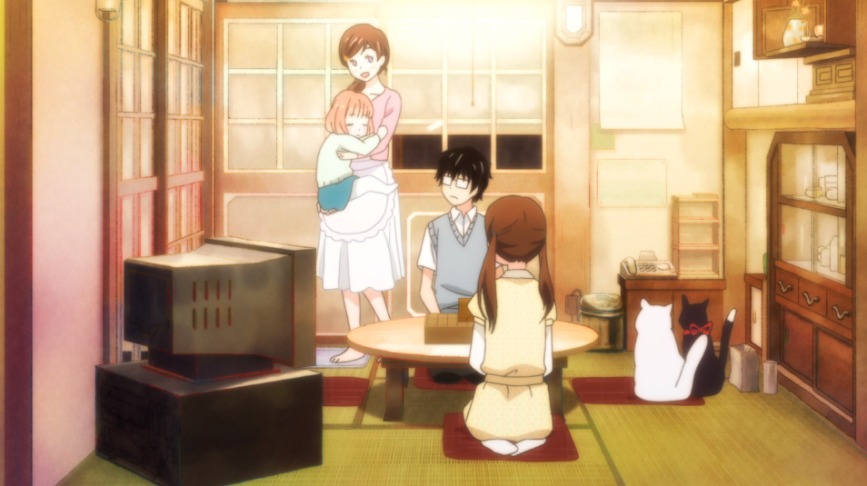
- Season 1: 22 episodes (Oct. 8, 2016-March 18, 2017)
- Season 2: 22 episodes (Oct. 14, 2017-March 31, 2018)
- Available to Watch on: Crunchyroll; Funimation
- Studio: Shaft
- Directors: Akiyuki Shinbo, Kenjirou Okada
- Source Material: Manga by Chica Umino (ongoing)
Synopsis
The protagonist of the series is Rei Kiriyama, a 17-18 year old shogi prodigy who plays professionally. Kiriyama was cared for by an older professional shogi player after his parents died, but he decided to move out and live on his own. He attends high school, although his attendance is somewhat sporadic due to his shogi commitments.
While living on his own, Rei befriended the Kawamoto family – primarily Akari Kawamoto (about 20) and Hinata Kawamoto (a middle school student). He often eats over at their house. While they know he plays shogi, they are unaware of the fact that he is a celebrity in the shogi world.
The show follows Rei’s shogi career, his friendship with the Kawamoto family, and one caring teacher at his high school, and it includes side stories involving other characters and professional shogi players. While shogi is a large focus of the show, large parts of it focus on other subjects – such as some difficulties that Hinata Kawamoto has in school.
Commentary
While this list is not a ranking, March Comes in like a Lion is, in my estimation, the finest show that aired from 2011-2020. No other show covers as much ground. At different times, we follow Rei’s adventures in the professional shogi world, his attempts to be a normal high school student, his difficult relationship with his adoptive sister, and his warm relationship with the Kawamoto family. Other arcs focus primarily on other characters – for example, the first season ends by focusing on another interesting professional shogi player, Kai Shimada – whose chronic stomach problems I found to be eminently relatable. For the most part, the stories about the supporting cast are as compelling as the arcs focusing on Rei.
Both seasons of March are excellent, but season two stands above and apart from the other top anime from the decade. Where the first season’s most compelling content dealt with Rei’s shogi career and his relationship with his adoptive family, the second season’s high point focuses on the character of Hinata Kawamoto and her difficulties with bullying in middle school, as well as Akari’s and Rei’s efforts to support her. The story is remarkably humane and accompanied by the best art direction and scripting in the series, and it is a shining example of the best of anime. Through the story, Hinata rises from a significant supporting character in the first season to one of the most notable and well-done characters in any series. There is, of course, plenty of excellent shogi content in the second season as well.
March covers a remarkable amount of ground and has stories about adults and children for all viewers. It is the best anime from the past decade and may see future seasons in the coming decade.
Additional Recommendations
Sing “Yesterday” for Me
- 12 episodes: April 4, 2020-June 20, 2020
- Available to watch on: Crunchyroll
- Studio: Dogakobo
- Director: Yoshiyuki Fujiwara
March is a unique show for the 2011-2020 period – while some shows are similar in certain aspects, no show is substantially similar to the whole product. Yesterday is an interesting show – albeit not on March’s tier in quality. Set in the late 90s, it follows a sort of love-square, focusing primarily on Rikuo Uozumi, an aimless college graduate who is interested in photography but afraid to put himself out there, Haru Nonaka, a high school dropout who has a crush on Rikuo, and Shinako Morinome, Rikuo’s college friend and the subject of his affections (we need not mention the fourth main character because he is annoying). The characters move forward in fits and starts, sometime step back, and always struggle to figure out what it is they want. Yesterday is a bit brooding, but interesting in that it focuses on stories and characters that are not entirely common in anime. While it does put viewers through some irritation, I was impressed to see it end in a decisive and satisfying way.
My Teen Romantic Comedy SNAFU (series)
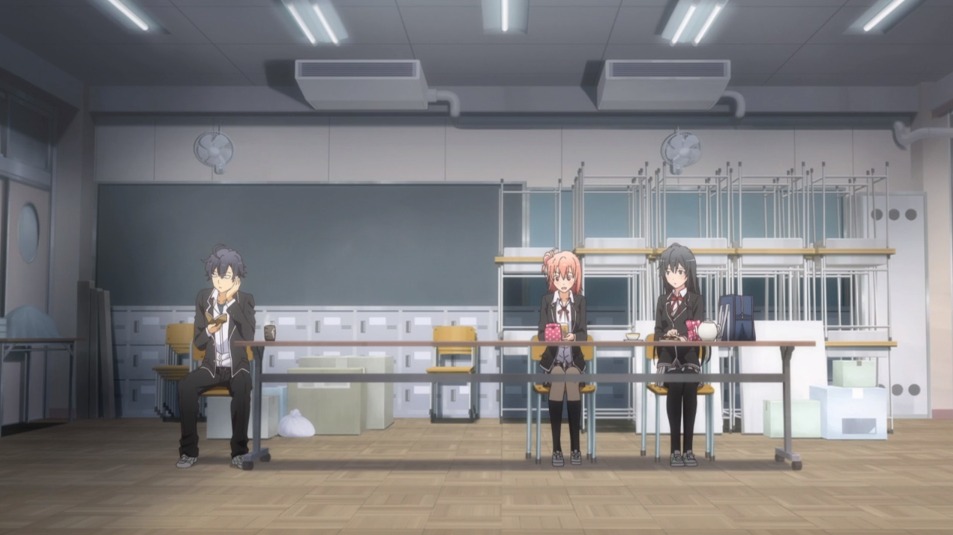
- (Season 1) My Teen Romantic Comedy SNAFU* – 13 episodes (April 5, 2013-June 28-2013)
- (Season 2) My Teen Romantic Comedy SNAFU Too!** – 13 episodes (April 3, 2015-June 26, 2015)
- (Season 3) My Teen Romantic Comedy SNAFU Climax – 12 episodes (July 9, 2020-Sep. 24, 2020)
- *OVA aired on September 19, 2013 (available to stream)
- **OVA aired on October 27, 2016
- Available to watch on: Crunchyroll; HiDive
- Studio: Brain’s Base (season 1); Feel (seasons 2 and 3)
- Directors: Ai Yoshimura (season 1); Kei Oikawa (seasons 2 and 3)
- Source Material: Lite novels by Wataru Watari
Synopsis
The story is told solely from the perspective of Hachiman Hikigaya, a second-year high school student (11th grade). He is a loner, remarkably cynical, and misanthropic. His concerned teacher forces him to join a club called the “Service Club” after he submits a dark essay denouncing people who enjoy their teenage years. There he meets Yukino Yukinoshita, noted in the school for her beauty and intelligence, but who also has no friends. While Hachiman and Yukino are similarly anti-social and introspective, their personalities often clash. They are eventually joined by Yui Yuigahama, a girl who is friendly and popular. Throughout the series, the Service Club solves problems posed to it by students in the school with varying degrees of success – and the viewpoints of Hachiman and Yukino sometimes come into conflict.
On a technical note, My Teen Romantic Comedy SNAFU is the only series mentioned in this article that had, at different times, different production studios. The first season was produced by Brain’s Base whereas the second and third were produced by Feel. The voice actors and actresses remained constant, but the first season utilized an art style similar to the light novels whereas the second and third seasons opted for a more realistic and serious art style. The continuity between the first and second season is perfect, but the change in art direction is notable.
Commentary Part I
I decided not to watch the first season as a simulcast because of its frivolous-sounding name. I am glad, however, that I did watch it in time to realize my error and enjoy the second season as a simulcast.
Again noting that this list is not intended to be a ranking, the three seasons of My Teen Romantic Comedy SNAFU, taken together, are surpassed only by March Comes in like a lion for the 2011-2020 period. SNAFU works because the viewpoint character, Hachiman Hikigaya, is an excellent narrator. He is a fundamentally good person with a twisted outlook on life. He is impressively introspective but also introspective to his fault and, as he is described in the show, monstrously self-conscious. During the show’s most difficult points, careful viewers will catch what he is missing in his conflicts and misunderstandings with other characters, usually Yukino and Yui.
Hachiman can be forgiven for his misunderstandings, for Yukino is a highly enigmatic character. They often bicker, struggle to communicate, and make unfounded assumptions about each other in both directions. Yukino, like Hachiman, is a good person who is often correct but not always right. Yui, for her part, is less intelligent than Yukino and Hachiman, but at times she is more mature and aware of her surroundings, despite her appearance and manner.
Commentary Part II
The first season of My Teen Romantic Comedy SNAFU introduces almost the entire main cast, save for one major character who does not feature until the second season. The first season is a succession of service club activities, starting with relatively innocuous problems and solutions and concluding with several heavy-handed (and arguably underhanded) solutions courtesy of Hachiman. In the second season, the three characters come into conflict, primarily due to certain actions by Hachiman and Yukino’s communication issues, forcing Hachiman to begin thinking about what it is that he really wants. The result of Hachiman’s deliberations sets the events for the resolution of their issues.
Despite the show’s name, “romance” does not feature heavily until the latter stages of the show. The third season focuses primarily on the resolution of the relationships between the four main characters (the three I mentioned plus one character who appears in the second season). While many anime series cop out on providing a decisive conclusion, the final season of My Teen Romantic Comedy SNAFU delivers, resolving the main conflicts (for better or worse) and bringing an end to a show that ultimately covered only a single year in the life of the characters. In light of the fact that the author cared deeply for the main cast and wrote the lead characters sympathetically, I credit him for resolving the series in a way that recognized that not everyone could obtain what they wanted.
Read My Earlier Article
Just after the third and final season of My Teen Romantic Comedy SNAFU concluded, I wrote an article on site about the end of a worthwhile journey. The author of the underlying lite novel series described his second year of high school as the longest year of his life, but that by concluding his series about his characters finishing their second year of high school, he felt like his time in high school had finally ended. I thought that it was a very relatable idea, and it highlights one of the best aspects of the series. You can read my spoiler-free thoughts here. See all of my content for the series in our Oregairu archive page.
Additional Recommendations
Hyouka
- 22 episodes (April 22, 2012-Sep. 16, 2012)
- Available to watch on: Funimation
- Studio: Kyoto Animation
- Director: Yasuhiro Takemoto
Hyouka is a “mystery” show of sorts. The protagonist, the somewhat listless Hotaro Oreki, is wrangled into joining his school’s Classic Literature Club in order to prevent it from being shut down due to lack of members. In this capacity, he befriends Eru Chitanda, a smart and energetic girl who forces him to apply his reasoning to solve mysteries that she is curious about. The mysteries are fortunately not of the Agatha Christie variety, but watching the characters interact with each other and their environment is enjoyable, and Oreki is a strong lead, having much of Hachiman’s apathy, see above, but being far better adjusted to society. Hyouka is well-written, beautifully animated, and one of the best shows of the last decade for those who have a taste for slow-paced character pieces.
Sound! Euphonium
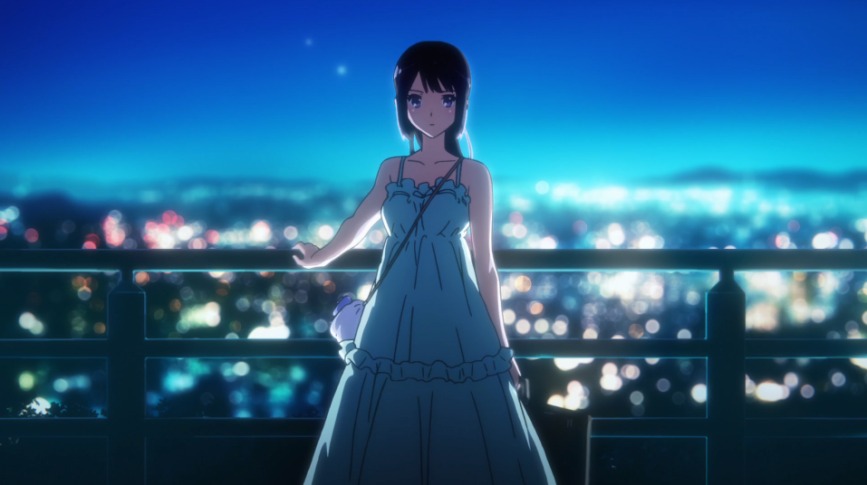
- (Season 1) Sound! Euphonium – 12 episodes (April 8, 2015-July 1, 2015)
- (Season 2) Sound! Euphonium 2 – 12 episodes (Oct. 6, 2016-Dec. 28, 2016)
- Available to watch on: Crunchyroll
- Studio: Kyoto Animation
- Director: Tatsuya Ishihara
Many anime from the past decade have gone with the apathetic and directionless male lead – with none doing it better than My Teen Romantic Comedy SNAFU. Sound! Euphonium a twist on the trend by employing an often-apathetic and indecisive young lady, Kumiko Oumae, as the lead. She joins her high school’s band, playing the euphonium, and the show focuses primarily on her and the various social dynamics and discord in the band. Euphonium is one of the prettiest anime seriesof the decade (see above), and it succeeds at presenting low-key drama without veering into melodrama. I must confess that I actually have not yet watched the second season – because it will require me to re-watch the first, but it is on my 2021 to-do list. An easy-to-recommend show for people who like good character-pieces and music, so long as they can stomach the high school setting.
May 13, 2022 Update: I finally got around to watching season 2 of Euphonium. Season 2 (which is followed by a movie and a forth coming third season) has more drama than the first. While good, it does not quite match the quality of the first season.
White Album 2
- 13 episodes (Oct. 6, 2013-Dec. 29, 2013)
- Available to watch on: Crunchyroll
- Studio: Statelight
- Director: Seiya Numata
Despite its name, White Album 2, which has nothing to do with the Beatles (you will have to read Victor’s content for that), is not a true sequel to the original White Album, so no prior knowledge is required. The show depicts a train wreck of a love triangle between three high school seniors. The train wreck is pushed forward by the fact that two parties to the love triangle are dense, with one having severe communication issues, while the third pushes events forward without fully considering the situation that they are in. Despite its many excesses, White Album 2 is a very good show on the whole, and perfect for a somewhat-dark winter watch. It is not particularly similar to My Teen Romantic Comedy SNAFU, eschewing ancillary issues for a heavy focus on romance. But it shows what can happen when the parties to a love triangle consistently behave in ways that are not entirely in accord with reason. I suppose, however, that things could have gone worse.
Tsuki ga Kirei

- 12 episodes (April 6, 2017-June 29, 2017)
- Studio: Feel
- Available to watch on: Crunchyroll; Funimation
- Director: Seiji Kishi
- Source Material: Original
Synopsis
Unlike the first two shows on the list, Tsuki ga Kirei (“As the Moon, So Beautiful”) is very simple. The show focuses on ninth grade students – Kotarō Azumi and Akane Mizuno. Kotarō is bookish – he admires the brilliant (and very depressing) Japanese novelist, Osamu Dazai – and he dreams of being a novelist. Akane is the star of the school track team and a top student (unlike Kotarō, who is a mediocre student despite his love of reading). They fall for each other, begin dating, but face the looming possibility that they will be separated upon starting high school. Throughout their courtship and relationship, each earned the affections of another – adding some complexity to the proceedings.
Commentary
Continuing my theme of rankings in a list that is not a ranking, Tsuki ga Kirei is probably my third favorite series of the decade. The vast majority of anime romance stories involve high school or high school-aged protagonists, making Tsuki ga Kirei stand out with its focus on junior high school students.
Tsuki ga Kirei is a simple romance story, but beautiful in its simplicity. It has unusually little dialogue for anime, featuring long stretches where the characters say little at all. No show does a finer job at carefully conveying how characters feel through their movements and expressions, and the show often speaks loudly by speaking little. The characters have no grand problems that are out of the ordinary, and neither Kotarō nor Akane are remarkable in any way. While each has a rival suitor, the heartbreak and occasional excesses of other anime love triangles and other myriad-sided shapes is generally avoided. Tsuki ga Kirei is excellent because it sticks to one subject and handles it about as well as it can be handled. It is technically sublime, lovingly crafted, and well-worth watching for all but those who cannot handle shows with very little action.
The Meaning of “tsuki ga kirei”
I published a comprehensive article on the real history and meaning of the phrase tsuki ga kirei on March 14, 2021.
Additional Recommendations
Flowers of Evil
- 13 episodes (April 5, 2013-June 29, 2013)
- Available to watch on: Crunchyroll; HiDive
- Studio: Zexcs
- Director: Hiroshi Nagahama
Like Tsuki ga Kirei, Flowers of Evil features a male protagonist in middle school who loves difficult books (shockingly, Flowers of Evil) and has a secret crush. Also like Tsuki ga Kirei, the show features relatively little dialogue and focuses heavily on showing feelings through gestures. In most every other sense, the show is quite different. This does not tell the tale of a cute junior high school romance. Instead, our hapless protagonist ends up in a manipulative non-romantic relationship with a girl in his class who is legitimately disturbed and intent on psychologically abusing him until he hates himself as much as she hates herself. Things always find a way to get worse. The show has the most unique animation style of any show from 2011-2020 – not necessarily for the better, and it ends somewhat in the middle of things. Nevertheless, even with its flaws granted, Flowers of Evil is a compelling watch for those who can stomach it, and it provides a simultaneously stark, dark, and compelling contrast to Tsuki ga Kirei.
Wandering Son
- 11 episodes (Jan. 13, 2011-March 31, 2011)
- Available to watch on: Crunchyroll
- Studio: AIC Classic
- Director: Ei Aoki
Wandering Son shares the middle school setting of the first two shows but features two main characters – a boy and a girl – with varying degrees of gender dysphoria, and a number of other interesting characters, chief among them the long-time friend of the two gender dysphoric characters who has a crush on one and a rotten personality to match. Wandering Son is the most aesthetic anime of the past decade, with beautiful pastel art and a terrific piano-based soundtrack, and it is well-written, although the characters sound quite a bit older and more mature than typical middle school students. It is a very interesting piece without being preachy, and it is not nearly as dramatic as one might expect.
Showa Genroku Rakugo Shinju
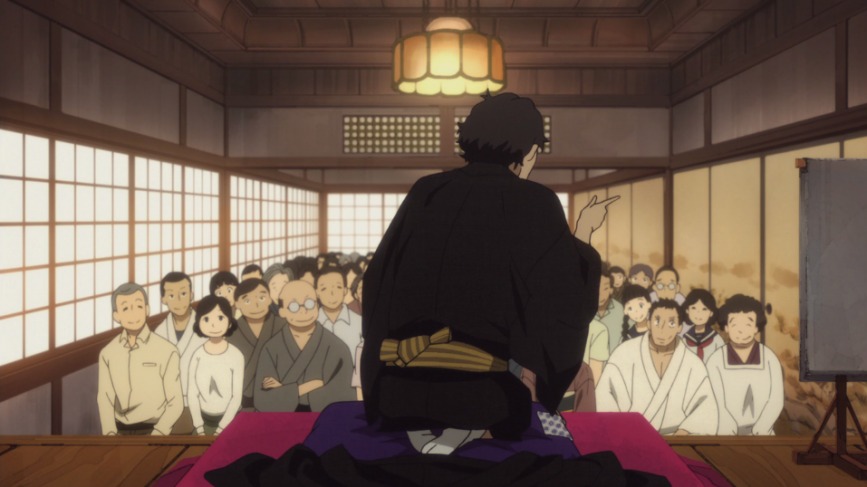
- Season 1: 13 episodes (Jan. 9, 2016-April 2, 2016)
- Season 2: 12 episodes (Jan. 7, 2017-March 25, 2017)
- Available to watch on: Crunchyroll (link)
- Studio: Studio Deen
- Director: Shinichi Omata
- Source Material: Manga by Haruko Kumota
Synopsis
The series begins when a famous rakugo storyteller, Yakumo Yurakutei, accepts as his apprentice a man named Kyoji who was recently released from prison. Kyoji became inspired to learn the art of rakugo after seeing Yakumo perform at his incarceration facility.
The first season is dedicated entirely to Yakumo telling his life story, from his being taken as a rakugo apprentice in the late 1930s and through the ensuing decades. Much of his life story also tells the story of his late friend and fellow rakugo storyteller, Sukeroku Yurakutei. These stories take the characters through World War II and the many decades of change in Japan after the war.
The second season picks up ten years after the start of the anime and is set in the present day. Yakumo is growing very old and weak, and Kyoji has become the successor to the late Sukeroku, adopting his name. The original Sukeroku’s daughter, Konatsu, who was taken in by Yakumo but has a difficult relationship with him, also features in the second season. In addition to exploring the complicated character dynamics between Yakumo, the new Sukeroku, and Konatsu, the second season also examines performing rakugo in the modern day, and it makes for an interesting comparison to the first season, which depicted times when more people were interested in rakugo. While it is impossible to say much more without spoiling the story, I will note that the second season concludes on a nice note.
Commentary
Showa Genroku Rakugo Shinju is both a great character drama and a picture of how Japan changed from the period right before World War II to the present. Unlike the other shows on my list, Rakugo Shinju deals entirely with adults, save for the first couple of episodes in the first season. The main five characters (including the love interest of Yakumo and Sukeroku in season one) are well-developed and complicated. The team behind the series put a large amount of work into the rakugo performance scenes in order to make them as authentic as possible in conveying the uniquely Japanese story-telling form.
Showa Genroku Rakugo Shinju has the most ambitious plot of any show on my list, covering many decades, and it is decidedly aimed at older viewers. Both seasons are excellent, but I found the first to be the more interesting of the two. It comes with my high recommendations for anyone who is interested in strong character dramas and/or Japanese culture.
Humanity Has Declined
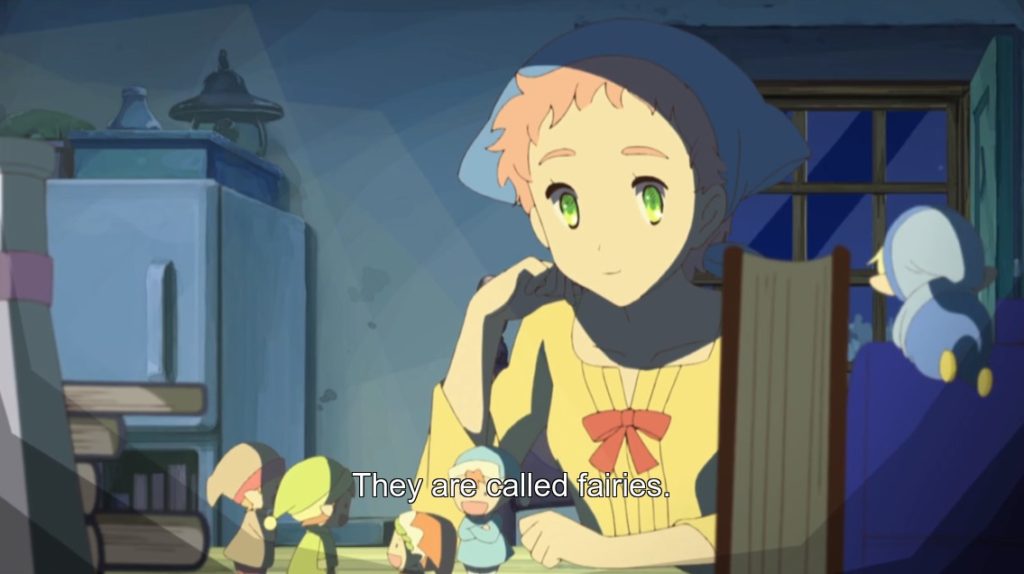
- 12 episodes (July 2, 2012-Sep. 17, 2012)
- Available to watch on: HiDive
- Studio: AIC A.S.T.A.
- Director: Seiji Kishi
- Source Material: Lite novels by Romeo Tanaka
Synopsis
The show takes place in a post-apocalyptic world where humanity has had a long and slow decline. The show is told entirely from the viewpoint of a nameless protagonist – usually called “Mediator” –whose job it is to mediate between the dwindling number of humans and the fairies, small mischievous creatures that are capable of great things but who have a tendency to cause trouble. Mediator deals with several other humans and robots as well throughout the show’s run.
Humanity Has Declined is notable for the fact that its episodes are not in chronological order. Episodes 1 and 2, which compose one arc, take place somewhere toward the end. The final two episodes, 11-12, cover events that occur before the other episodes.
Commentary
Humanity Has Declined is the most bizarre of my ten showcase recommendations, but the dark comedy with bright, colorful, and cheery visuals somehow works well.
The nameless viewpoint character, “Mediator,” is excellent, and she is the best narrator other than Hachiman Hikigaya from SNAFU. She has a sense of humor about the ridiculous situations that she finds herself in, usually due to the mechanizations of the fairies. Mediator has a sardonic sense of humor and is understandably nihilistic from having witnessed the decline of humanity. In the end, she knows that most of what is going on around her does not really matter, and she gets carried along with the strange events.
The fairies defy easy explanation. Their faces are permanently affixed with large smiles and they love sweets, but the first episode features fairies making jokes about mass starvation when Mediator informs them that she has no sweets to bribe them with. Most of the strange events in the show are caused by the fairies being mischievous, not thinking, or mildly sociopathic. Mediator’s dry sense of humor leads to many memorable exchanges with the fairies.
Humanity Has Declined‘s numerous arcs cover many events. In one case, Mediator may be forced to partake in an unfortunate renaissance for boys-love manga, whereas in another she may witness the rise and fall of a civilization. Neither of those arcs cover the show’s most meme’d moment, when a sentient slice of bread tore itself asunder. Despite all of these absurd situations, the show ends on a touching note.
Humanity Has Declined is an acquired taste. Having acquired that taste somewhere along the road, I think that it is the best anime comedy of the past decade, and well worth your consideration.
Additional Recommendations
Monthly Girls’ Nozaki-kun
- 12 episodes: July 7, 2014-Sep. 22, 2014
- Available to watch on: HiDive
- Studio: Doga Kobo
- Director: Mitsue Yamazaki
Humanity Has Declined defies easy categorization or comparisons. As I vaguely referenced, one of its arcs involves the (arguably unfortunate) rediscovery of low-rent boys-love manga, which is aimed primarily at young women in Japan. But many young women prefer manga featuring relatively ordinary young ladies like themselves who are swept off their feet by a variety of stunning men pursuing their affection. Monthly Girls’ Nozaki-kun stars a high school manga artist in the latter category – Umetarou Nozaki. Despite his being a popular manga, he has little personal understanding of love, which makes him impervious to the affections of his classmate, Chiyo Sakura, who he uses as his assistant. The show, however, is not serious, but a terrific romantic comedy that makes plenty of trope-based jokes. Perhaps the best running gag in the series involves the character of Mikoto Mikohiba, another student who helps Nozaki. While Mikoto comes off as a traditional protagonist in a girl’s manga, his behavior and interactions lead Nozaki to use him as character inspiration for his heroines instead of her suitors. Although the show is best appreciated by those with some knowledge of manga tropes, it would probably be enjoyable without much context.
Ping Pong the Animation
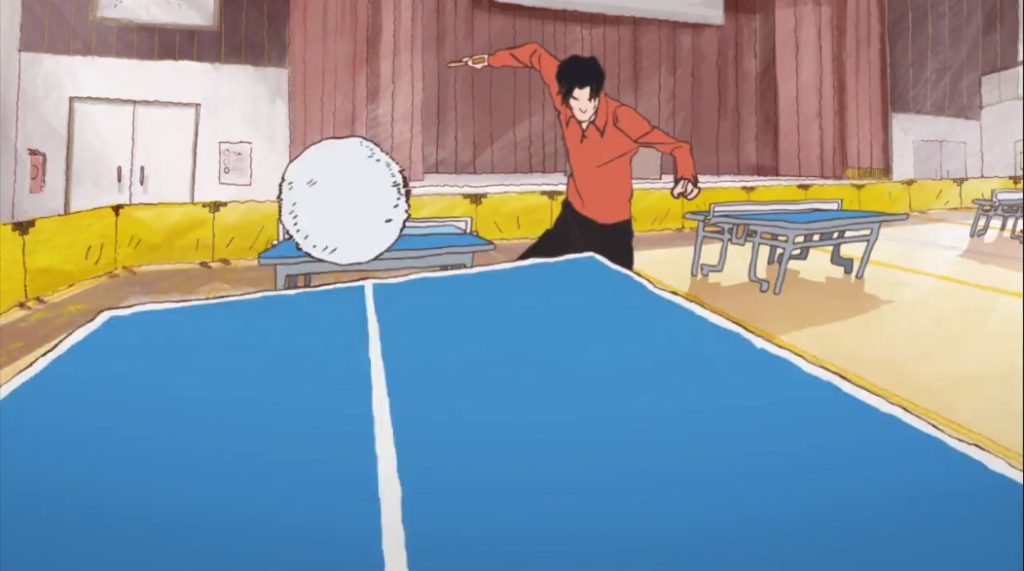
- 11 episodes (April 11, 2014-June 20, 2014)
- Available to watch on: Funimation
- Studio: Tatsunoko Production
- Director: Masaaki Yuasa
- Source Material: Manga by Taiyō Matsumoto
Synopsis
Ping Pong the Animation is a psychological sports anime. The series begins with two long-time friends and classmates, “Peco” and “Smile,” who are first-year members of their high school table tennis team. Despite being first-year players, they are both vastly more talented than their fellow members. Smile, who is reserved and taciturn, has always looked up to the loud and confident Peco and followed his lead. However, coaches and opposing players take the view that Smile is the more talented of the two, and he begins a meteoric rise while Peco struggles against talented players he cannot easily overwhlem.
Over the course of the show, we encounter several other players who become main characters. There is Ryūichi Kazama, the top high school player in Japan and a world junior champion. Kong Wenge is an elite player from China who arrived in Japan to play after being kicked off the Chinese national team. Finally, one of Kazama’s teammates is Manabu Sakuma, a childhood rival of Peco who tries to compensate for what he lacks in natural talent with hard work.
How much of success in table tennis is owed to natural talent? Can hard work overcome a lack of talent? Is it possible to reach the highest levels of table tennis if you do not actually enjoy it? Is it possible to enjoy the fruits of success when the battle to stay on top makes you sick? Can you do everything in table tennis alone? The characters face these questions and many more throughout the series’ run.
Commentary
I did not watch Ping Pong for several years after it aired because I thought that the anime style was unaesthetic. Fortunately, I came around.
To start, it is impossible to talk about Ping Pong without noting its very distinctive animation. To be sure, the characters are not pretty, but the show is actually very well animated. I will note that the attempt at realism works in a way, although I still would not call it pretty.
I tend not to watch many sports anime. For one, I know enough about many sports that the lack of realism in shows grates on me. For two, many sports anime are formulaic, featuring characters who manage to overcome any number of natural deficiencies through hard work. Ping Pong, however, examines at questions about talent, work ethic, and enjoying what you do in a serious way. Each of the five main characters faces difficult questions regarding their futures in ping pong, and none finds easy answers. In addition to each character learning that success requires both natural talent and hard work, the characters also grapple with questions about success and happiness and failure and sadness.
Ping Pong is a short series, but every episode is meaningful. The penultimate episode is the best of the series and one of the most memorable episodes of any series in the past decade. For the high school anime-averse, I will add that the show never deals with school life or academics. Of all the shows on my list, this one may be the easiest one to recommend to all readers.
Additional Recommendations
Run with the Wind
- 23 episodes: October 2, 2018-March 26, 2019
- Available to watch on: Crunchyroll
- Studio: Production I.G.
- Director: Kazuya Nomura
Run with the Wind was very nearly one of my ten principal recommendations, but instead I opted to add it as an additional recommendation to Ping Pong. The show is set in an off-campus housing unit of a Japanese university. Haiji Kyose, a college senior and experienced runner whose college running career had been derailed by injuries, has slowly selected residents for the housing unit to form a track team, with dreams of qualifying to run in the Hakone Ekiden (a relay-marathon of sorts). After applying some coercion, the team set to training, with only Haiji and a freshman he forced to join, Kakeru Kurahara, being experienced and talented runners. The show is more a character piece than a sports piece, giving each of the members of the team a turn in the spotlight as they grow through running and contemplate their future plans. Whether the ragtag crew makes it to Hakone Ekiden will be left to those who watch. It is a very pleasant and interesting series and easy to recommend. In an additional interesting note – it is based on a novel by Shion Miura, who gained some notoriety in the United States when another one of her novels, The Great Passage, was translated and published in English (that too was turned into an anime, but I have not seen it).
Chihayafuru
- Season 1: 25 episodes (Oct. 4, 2011-March 27, 2012)
- Season 2: 25 episodes (Jan. 11, 2013-June 28, 2013)
- Season 3: 24 episodes (Oct. 22, 2019-March 24, 2020)
- Available to watch on: Crunchyroll; HiDive
- Studio: Production I.G.
- Director: Morio Asaka
Chihayafuru is a sports anime of sorts, but the “sport” in this case is karuta, a Japanese game where two players compete to take cards from each other as quickly as possible. The show focuses primarily on the school karuta club of Chihaya Ayase, who is a very talented young karuta player. The club competes in national high school tournaments, and Chihaya and some of her peers and mentors compete in professional events as well. It is a more traditional sports anime than Ping Pong, but it avoids the excesses that haunt many entries in the genre. The first season was the best of the three, in my estimation, and the show is held back a bit by the fact that Chihaya has limitations as a main character. But on the whole, it is a good show both for those who enjoy well written content and sports and competition and those who are interested in learning about an uniquely Japanese card game.
Shirobako
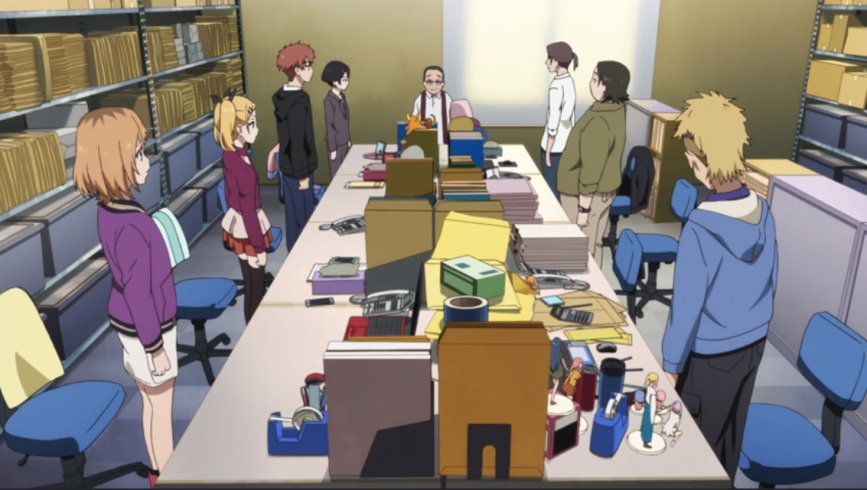
- 24 episodes (Oct. 9, 2014-March 26, 2015)
- Available to watch on: HiDive
- Studio: P.A. Works
- Director: Tsutomu Mizushima
- Source Material: Original
Synopsis
Five friends who made up an anime production club in high school dreamed of working together to make a real anime one day. The show picks up with the five joining the workforce and trying to make their way in the anime industry. Along the way, the series gives a great deal of attention to other characters they work with at their respective jobs.
While Shirobako has many important characters, the main protagonist is Aoi Miyamori, who starts as a production assistant at Musashino Animation and works her way up throughout the show. The majority of the show follows Musashino Animation, although many of the main characters do not work for Musashino Animation for much of the series.
Commentary
Shirobako, focusing on anime production, is a relatively uncommon workplace anime. While the show presents an idyllic picture of anime production, both Musashino Animation and the main characters go through a great deal of stress, and much self-doubt, throughout the show’s 25 episodes. Beneath the workplace comedy and drama is the dream of the five young women who made up a high school animation club to work together on making a professional anime. It would be wrong of me to reveal how much progress they make in that journey.
Shirobako is a terrific character piece and an enjoyable show to watch, owing to its strong writing and positive outlook. There is also much to recommend for those who are interested in anime and anime production generally, notwithstanding the show’s idealized portrait of one fictional company in the industry. Shirobako is not the most thematically compelling show on the list, but it is one of the easier to recommend without many qualifications.
Additional Recommendations
Sakura Quest
- 25 episodes: (April 5, 2017-Sep. 20, 2017)
- Available to watch on: Funimation
- Studio: P.A. Works
- Director: Soichi Masui
Sakura Quest was made by the same studio as Shirobako. Furthermore, the protagonist bears an eerie resemblance to that anime’s Aoi Miyamori. However, instead of pursuing her dream job in anime production, Yoshino Koharu ends up working as the “Queen” for the tourism department of a small village The show follows her work with her colleagues at the department. To call it the “small village tourism department” version of Shirobako would only be a minor overstatement, but Sakura Quest is good in its own right, and it grew on me over the course of my watch. While I think that Shirobako is the better of the two shows, I could see how some viewers with no interest in anime production could prefer Sakura Quest. It is a fine series that grows stronger over the course of its 25-episode run.
Girlish Number
- 12 episodes: Oct. 7, 2017-Dec. 23, 2016
- Available to watch on: HiDive
- Studio: Diomedea
- Director: Shōta Ihata
- Writer: Wataru Watari
Most anime about anime paint a rosy picture of the industry and anime production. Shirobako was no exception to the rule, although it managed to avoid the trap being too self-congratulatory. Girlish Number goes the other direction. The show was written by Wataru Watari of My Teen Romantic Comedy SNAFU fame, and it follows an over-confident, cynical, and lazy aspiring voice actress. The show follows her work on a tire fire of a show along with her colleagues, and it offers a less rosy picture of the anime industry. I ultimately had mixed feelings about Girlish Number – it is good on the whole, but not the most pleasant watch. For those who have an interest in the subject, however, it provides an interesting alternative perspective to Shirobako. Having an excellent writer, the script is good, although it lacks the charm and depth of My Teen Romantic Comedy SNAFU.
Fruits Basket

- Season 1: 25 episodes (April 6, 2019-Sep. 21, 2019)
- Season 2: 25 episodes (April 6, 2020-Sep. 21, 2020)
- Available to watch on: Crunchyroll; Funimation
- Studio: TMS/8PAN Director: Yoshihide Ibata
- Source Material: Manga by Natsuki Takaya
August 2022 Update: I reviewed the third season of Fruits Basket in brief in my article on the best anime series of 2021.
Synopsis
The protagonist of Fruits Basket is Tohru Honda, a ditzy and impossibly kind high school student who heals hearts with her unrelenting optimism. She begins the show living in a tent after her mother passes away and her grandfather was not ready to take her in due to home renovations. Tohru is found by Shigure Soma, a man in his 20s, and Yuki Soma, Shigrue’s cousin and Tohru’s classmate. Being unable to accept Tohru living in a tent, they bring her to their large home, where they are soon joined by Kyo Soma — another relative and a classmate of Yuki and Tohru, who has bit of an attitude.
Tohru discovers that the Somas have a family secret. 13 members of the family, including Shigure, Yuki, and Kyo, are possessed by zodiac anime spirits, and they turn into their corresponding zodiac anime if they are hugged by a member of the opposite sex who is not one of the zodiac animals. This circumstance, along with other circumstances relating to the Soma family curse, causes the zodiac members varying degrees of distress. Tohru eventually moves in with the Somas permanently and gradually meets the other zodiac members. She develops a determination to break the curse that binds them and to help Yuki and Kyo overcome their past traumas and future concerns.
Commentary
The ongoing Fruits Basket series is the second anime adaptation of the well-known manga – the first, good in its own right, aired in 2001 (the 2001 adaptation is also available on Funimation). Fruits Basket effectively mixes comedy (hit and miss, but very good when it hits) with drama, generally keeping the mood from becoming too consistently light or heavy.
Tohru, with her ineffable kindness and enthusiasm, is the heroine of the story, and Yuki and Kyo function as co-main characters, but each of the main members of the Soma family as well as Tohru’s two best friends have their day in the sun with their own character arcs. Those arcs vary somewhat in quality, with some being superlative and others not quite hitting the mark – but some degree of inconsistency is to be expected in a 50-episode series. Fruits Basket is, through it all, consistently pleasant and, in its better moments, provides some of the highlights of the last decade in anime.
Unlike the previous shows on the list (with the possible exception of March Comes in like a lion), Fruits Basket is an ongoing series, scheduled to resolve its hanging plot lines in 2021 in a third season. On the whole, the series is a slow burn and not a prefect recommendation for everyone. But no show combines heavy drama through tragic circumstances and comedy quite like Fruits Basket. If the premise sounds interesting to you, it is worth a try.
Additional Recommendations
Croisée in a Foreign Labyrinth
- 12 episodes; July 4, 2011-Sep. 19, 2011
- Available to watch on: HiDive
- Studio: Statelight
- Director: Kenji Yasuda
Set in the late nineteenth century, this charming and little-noticed series stateside follows Yune, a young Japanese girl, who stays for several months with a French family that runs an ironwork shop in Paris. Much of the show focuses on Yune’s relationship with Claude Claudel, who works at the shop, and his upper-class friends, Alice and Camille Blanche. Little of consequence happens, and the show is slow-paced and peaceful. It is the type of series that has a way of growing on one over time, and the final product leaves a good impression. While seeing French people speak Japanese is a bit jarring, the show is good enough to let it slide. Episode 7, which focuses on the older Blanche sister, is the show’s standout.
Golden Kamuy
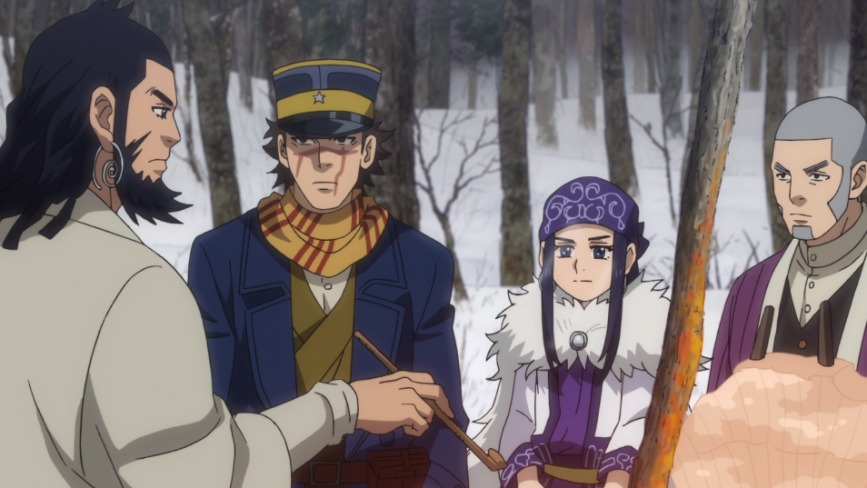
- Season 1: 12 episodes (April 9, 2018-June 25, 2018)
- Season 2: 12 episodes (October 8, 2018-December 24, 2018)
- Season 3: 12 episodes (October 5, 2020-December 21, 2020)
- Available to watch on: Crunchyroll; Funimation
- Studio: Geno Studio
- Director: Hitoshi Nanba
- Source Material: Manga by Satoru Noda (ongoing)
Synopsis
Golden Kamuy is set in Hokkaido shortly after the end of the Russo-Japanese War. Saichi Sugimoto, a veteran of that war, learns of a story that escaped convicts from a prison in Japan have tattoos on their backs with instructions pointing to a massive trove of Ainu gold. As he began his search, he encountered a young Ainu girl named Asirpa, who wanted to avenge her father, and they agreed to work together.
As the story progresses, we learn that many other people and factions are interested in the gold, including a division of the Japanese military, some of the escaped convicts, former samurai, Ainu, and probably more who I am forgetting. Characters who may be in a fight to the death in one episode may be allies later in a later episode.
Commentary
In the spirit of this being a list of recommendations rather than a ranking, I will note from the outset that Golden Kamuy is not one of the 10 best series of the decade – although it is quite good. Unsurprisingly for a show with a very large cast and many moving parts, it starts a bit slow but improves as it goes along, fully hitting its stride in the latter half of the second season and in the third season.
Golden Kamuy is a grand, sometimes complicated, adventure, with plenty of action and a sense of humor – not always in perfect taste. It is a credit to a show with a cast the size of Golden Kamuy’s that most of its characters are memorable – first and foremost, Sugimoto and Asripa. While the story is a work of fiction, the team behind the show paid great attention to detail, using native speakers of various Ainu languages and Russian, where necessary. The show not only depicts different Ainu societies but also addresses general changes in Japanese society beginning with the Meiji Restoration and accelerating after the Russo-Japanese War. For its part, the memory of the that war looms large in the story, with many of the characters having served in it.
Golden Kamuy is the finest adventure show and historical drama of the decade. It is not appropriate for all viewers in light of its violence and some of its jokes, but it is perhaps the easiest show to recommend for those who have no particular interest in anime. Furthermore, the end of the third season leaves open the possibility that the series will continue in the future.
Additional Recommendations
Fate/Zero
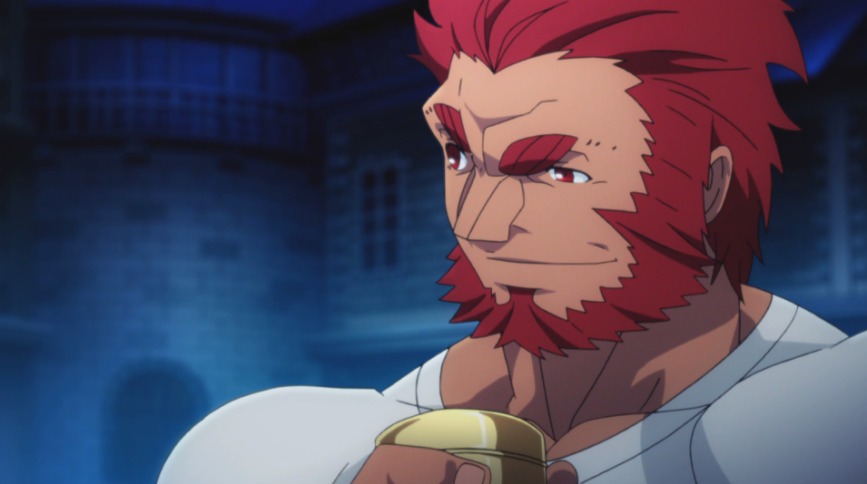
- (Season 1) 13 episodes (Oct. 1, 2011-Dec. 24, 2011)
- (Season 2) 12 episodes (April 7, 2012-June 23, 2012)
- Available to watch on: Crunchyroll; Funimation
- Studio: Ufotable
- Director: Ei Aoki
Fate/Zero is an original anime production set in the Type/Moon universe, which has produced a series of video games and anime movies. The show follows the “Holy Grail War,” wherein seven mages summon one heroic spirit apiece and fight each other to be the last one standing. The heroic spirits come from history – the show has an interesting take on King Arthur, but Alexander the Great steals the entire show. Fate/Zero is dark, gritty, and intense, and it benefits from the fact that most of the key players are adults (especially when compared to its lesser anime sequel, Fate/Stay Night – which I would not recommend). The series is a fun and sometimes brutal ride, and it carries the drama and uncertainty all the way through the end of its 25-episode run.
Puella Magi Madoka Magica
- 12 episodes: Jan. 7, 2011-April 21, 2011
- Available to watch on:
- Studio: Shaft
- Directors: Yukihiro Miyamoto and Akiyuki Shinbo
Similar to Golden Kamuy in no meaningful sense other than that it has some action and violence, I decided in the end that I should find a place for Magica Madoka on my list. It is, to be sure, one of the defining and iconic anime series of the 2011-2020 period, and while it is not my favorite, a friend who Victor referenced separately ranked it as the best series he had seen. As the name suggests, Magica Madoka is a magical girl anime, but while many magical girl anime series are bright and cheery, Magica Madoka is unrelentingly dark and brutal. In this world, being a magical girl means taking on despair. The series is tightly scripted and does not show its hand until its final stages. With no shortage of shocking moments and instances stunning animation, it is worth a try for those who find the premises at least somewhat intriguing.
Tonari no Seki-kun: The Master of Killing Time

- 21 episodes (Jan. 5, 2014-May 25, 2014)
- Available to watch on: Crunchyroll; HiDive
- Studio: Shin-Ei Animation
- Director: Yūji Mutoh
- Source Material: Manga by Takuma Morishige (ongoing)
Synopsis
Unlike every other show I discussed thus far, Seki-kun is a series of shorts, with each episode running about seven minutes. Tonari no Seki-kun is a gag comedy that focuses almost exclusively on two characters. The viewpoint character is not the eponymous Seki-kun but the beleaguered classmate who sits next to him, Rumi Yokoi. In every episode, Seki does something absurd in class that has nothing to do with school work. For her part, Rumi usually tries unsuccessfully to avoid being distracted by or roped into Seki’s antics. The results vary episode to episode. Seki never utters a word during the show’s entire run.
Commentary
In each of its 21 episodes, Tonari no Seki-kun delivers great comedy, and some of Seki’s time-wasting antics in class are impressively creative. While Seki is a hero to those of us who had a tendency to nod off in class or wanted to do anything else, Rumi’s running commentary on Seki and her reactions to his behavior make the show special. Going into any episode, one can never tell whether Rumi will have any success trying to avoid becoming roped into Seki’s joke of the day. In one episode, Rumi may be completely exasperated by Seki, while in another she may be more invested in what Seki is doing than Seki himself is. Left unstated is the fact that Rumi is developing an obvious crush on Seki throughout the proceedings.
Tonari no Seki-kun is a little gem that never overstays its welcome (in fact, I would welcome another season) and delivers many memorable comedic snippets. My personal favorite is episode 19 – wherein Seki decides to spend class trying on countless glasses frames. This episode is very relatable for anyone who has shopped for glasses at a glasses store or helped someone else do so. If you want to see how Seki’s desktop glasses store went over with Rumi, you will have to watch for yourself.
Additional Recommendations
Karakai Jozu no Takagi-san
- Season 1: 12 episodes (Jan. 8, 2018-July 12, 2018)
- Season 2: 12 episodes (July 7, 2019-Sep. 22, 2019)
- Available on: Crunchyroll (S1 only); Netflix
- Studio: Shin-Ei Animation
- Director: Hiroaki Akagi
Takagi-san, like Seki-kun, was produced by Shin-Ei Animation. Unlike Seki-kun, it is a full-length series. The main character, Takagi, a middle school girl, relentlessly plays pranks on her classmate, Nishikata. Nishikata always ends up on the losing end of his battles with Takagi, but he nevertheless spends entire episodes trying to get the better of her. Takagi is in love with Nishikita but plays pranks on him and enjoys his reactions instead of confessing. Nishikita is less emotionally mature than Takagi , and he is nearly as oblivious to his own growing feelings for her, which he is incapable of understanding, as he is to the blatantly obvious signs that Takagi is in love with him. The show is light-hearted throughout, but beneath the consistently good comedy lies some astute observations about how girls and boys experience their first crushes differently.
October 2, 2024 Update: I watched the second (2019) and third (2022) seasons of Takagi-san after originally publishing this review. The second season is my runner-up pick for anime of the year in 2019 and the third season was my choice for 2022 anime series of the year.
Kaguya-sama: Love is War
- Season 1: 12 episodes (Jan. 12, 2019-March 30, 2019)
- Season 2: 12 episodes (April 11, 2020-June 27, 2020)
- Available on: Crunchyroll (S1 only); Funimation
- Studio: A-1 Pictures
- Director: Shinichi Omata
Another absurd romantic comedy, this one set in high school. The show stars Miyuki Sirogane and Kaguya Shinomiya, the president and best student in the school and the vice president and second best student in the school, respectively. To be sure, the leads are in love with each other. However, their mutual pride and self-consciousness lead them to view love as a war, and whoever reveals their feelings is the loser. Each episode is broken into a series of skirmishes, after which the show’s disembodied narrator opines on the outcome of the battle – with some battles being won by the supporting members of the student council. While the show is not at all serious, I will say that the extreme outlooks of Miyuki and Kaguya are not too far off the mark from some things that I have seen in real life. (Note: I have only seen the first season, but I look forward to watching the second season in the near future.)
October 2, 2024 Update: I watched the second season after writing this article and subsequently watched the third season as a simulcast in 2022. The second and third seasons were my anime of the year runners up in 2020 and 2022 respectively (see section on Kaguya in my 2022 anime review).